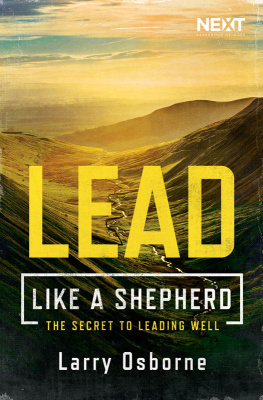Forward
Those of us in leadership today like to think of ourselves as shepherds, but we may have created shepherds in our own image. Tim Laniak agrees that, as Christian leaders, we should think of ourselves as shepherds, but he brings to our identity an unsettling biblical and cultural realism. Shepherding a flock in the Near East has always been demanding and often demeaning work, and it took all a person could give to do it well. Laniak, Dean and Professor of Old Testament at Gordon-Conwell Seminary, has spent a portion of his life researching shepherds up close and personal, and in the following pages he guides the reader to appreciateand embraceall that biblical shepherding involves.
Almost forty years ago Philip Keller wrote a soul-opening book, A Shepherd Looks at Psalm 23. The journey in the following pages will take you beyond that devotional classic. With insightful words and splendid photographs, Laniak brings both a scholars mind and a pastors heart to his writing. Elders and deacons, pastors, parents and seminary presidents are correct in regarding themselves as shepherds. While Shepherds Watch Their Flocks raises our job description to a divine standard.
Dr. Haddon W. Robinson, Former President,
Gordon-Conwell Theological Seminary
Also endorsed by Billy Graham, Leighton Ford, Bobby Clinton, John Perkins, Anne Graham Lotz and numerous Christian leaders from around the world (see following the endnotes).
WHILE SHEPHERDS WATCH THEIR FLOCKS
Forty Daily Reflections on
Biblical Leadership

Dr. Timothy S. Laniak
Photography by David Ormesher
ShepherdLeader Publications
www.ShepherdLeader.com
Dedicated respectfully to Dr. Robert E. Cooley,
a model shepherd who brings the highest level of scholarship
in Bible and Anthropology
to his understanding and practice of Christian leadership
Table of Contents
Acknowledgments
This book is the result of generosity from two institutions and countless individuals. Funding for my field research came from the Trustees of Gordon-Conwell Theological Seminary who provided me with a sabbatical in 200304. During that year the Trustees of the Albright Institute for Archaeological Research in Jerusalem supported my work as their Annual Professor. I feel deeply indebted to the many shepherds, mostly Bedouin, who took me into their tents and opened up their lives to me. Theyve honored me with trust to tell their stories to the world. My translator, Ste, was a gracious host through many long days of interviewing, offering not only his time but his friendship for life. May God grant him and his new bride many children and large flocks.
I want to thank a team of specialists who have contributed to this book and related resources. My long time friend Dave Ormesher took time off from his company in Chicago to share an adventure and get back behind a camera. Photos were also contributed graciously by Todd Bolen (www.bibleplaces.com), Jim Martin, Matt Doll, and other accommodating friends. I cant express my gratitude enough to editors Janet Thoma and Tabitha Plueddemann, midwives who helped me give birth to forty chapters that each came with labor pains. Layout was designed and executed superbly by Carl Etzel, artist extraordinaire, and Tyler Gordon, source of our daily pdfstwo men who proved patient with an author who found it too easy to ask, What if we tried? Many thanks to Tina and Jeremy Long who helped with image treatments and to Trish King and my mother, Jane Laniak, for proof reading.
I am indebted especially to three of the many spiritual shepherds who read early versions of the manuscript, took it seriously, and gave incisive feedback: Bob Thompson, Jamie Walters, and Tamara Park. Bob and Jamie continued working with the book after I was finished, organizing the discussion that led to the forums in The Tent at www.ShepherdLeader.com.
My appreciation runs deepest for my family. Our kids, Jesse and Adrienne, were great travelers (even on cranky camels) and joined in the fun of interviewing. Adrienne still reminds me that I needed her to translate for me. Jesse may regret turning down an offer to become a Bedouin someday. Aaron was studying back in the U.S.never able to explain to his friends why Dad spent a year with sheep and goats! My incredible wife Maureenmodel shepherd, partner in ministry, and my fellow sojourner in green pastures and dark valleys for more than thirty yearshas supported this project from its inception, as she has all of my endeavors. Her value, as my Bedouin friends would say, is greater than a thousand camels.

We are the people of his pasture,
the flock under his care.
Psalm 95:7
Introduction
Hey Mister!, what is there to research about us? We are nothing! Just spend our lives running after sheep and goats. Neither home, nor an address. Sleeping under the open sky, in winter, summer, and rainsYear after year we measure the length of roads by our feet, carrying cooking utensils on camels and mules. Cant even rest in one place for a week. Why waste time, then, yours and ours?
T hese are the words of young shepherds trying to make sense of an outsider studying their way of life. They find their own lives marginal and enigmatic, so why study them? Paradoxically, here on the fringes of society, a marginalized vocation older than civilization holds the key to understanding leadership in our own day. Not just leadership generally, but biblical leadership.
The following pages provide personal access into the lives of real shepherds. Shepherds from many countries across the Middle East and beyond. Shepherds from many historical periods. The kinds of shepherds the Bible makes much of. This book came as the result of my own personal journey into these lives, searching for the context and meaning of the persistent pastoral imagery in Scripture. I wanted firsthand exposure to the cultural fabric of this central metaphor chosen to convey profound and timeless truths about leadership.

tribes raise their flocks. I am indebted to so many for taking me into their tents and opening up their worlds to me. Their comments on the common everyday world of shepherd work began to shape my understanding of biblical passages on leadership in unexpected ways.
Returning to my work of training shepherds for the church, I found an eager audience for these images and insights and their implications for contemporary ministry. Though some have their doubts, I am convinced more than ever that the shepherd metaphor needs to be reinvigorated rather than replaced.
Through this book I invite fellow Christian leaders to trek into the wilderness and reflect together on our lives and work as shepherds. Seize this opportunity to reflect on your Divine Shepherd and your calling as his field hand. Ideally, set aside forty days for this personal journey. Well begin each day with a brief chapter, each a collage of photographic images, excerpts from interviews, scriptural insights, and thought-provoking questions. Let this book guide your personal sojourn in the wilderness.

















